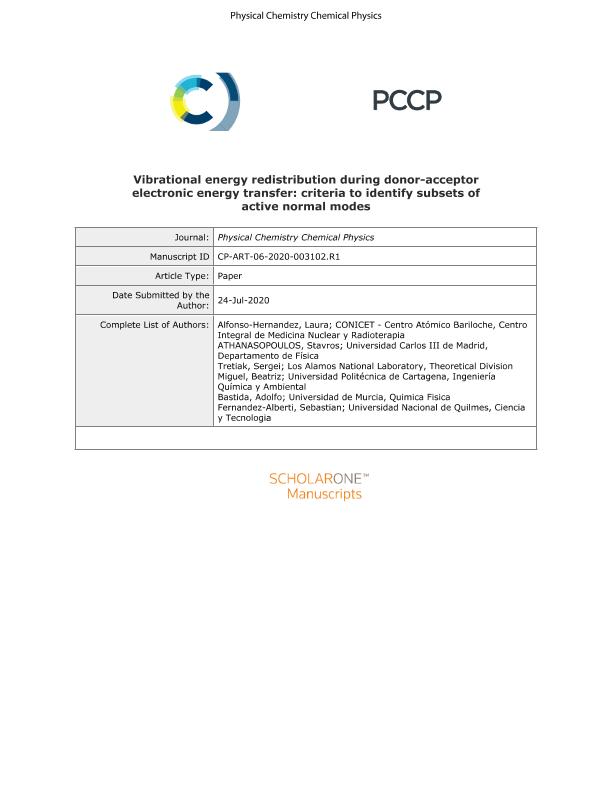Mostrar el registro sencillo del ítem
dc.contributor.author
Alfonso Hernandez, Laura

dc.contributor.author
Athanasopoulos, Stavros

dc.contributor.author
Tretiak, Sergei

dc.contributor.author
Miguel, Beatriz
dc.contributor.author
Bastida, Adolfo

dc.contributor.author
Fernández Alberti, Sebastián

dc.date.available
2020-09-29T21:49:24Z
dc.date.issued
2020-09
dc.identifier.citation
Alfonso Hernandez, Laura; Athanasopoulos, Stavros; Tretiak, Sergei; Miguel, Beatriz; Bastida, Adolfo; et al.; Vibrational energy redistribution during donor-acceptor electronic energy transfer: criteria to identify subsets of active normal modes; Royal Society of Chemistry; Physical Chemistry Chemical Physics; 22; 33; 9-2020; 18454-18466
dc.identifier.issn
1463-9076
dc.identifier.uri
http://hdl.handle.net/11336/115132
dc.description.abstract
Photoinduced electronic energy transfer in conjugated donor-acceptor systems is naturally accompanied by intramolecular vibrational energy redistributions accepting an excess of electronic energy. Herein, we simulate these processes in a covalently linked donor-acceptor molecular dyad system by using nonadiabatic excited state molecular dynamics simulations. We analyze different complementary criteria to systematically identify the subset of vibrational normal modes that actively participate on the donor → acceptor (S2→ S1) electronic relaxation. We analyze energy transfer coordinates in terms of state-specific normal modes defined according to the different potential energy surfaces (PESs) involved. On one hand, we identify those vibrations that contribute the most to the direction of the main driving force on the nuclei during electronic transitions, represented by the non-adiabatic derivative coupling vector between donor and acceptor electronic states. On the other hand, we monitor normal mode transient accumulations of excess energy and their intramolecular energy redistribution fluxes. We observe that the subset of active modes varies according to the PES on which they belong and these modes experience the most significant rearrangements and mixing. Whereas the nuclear motions that promote donor → acceptor energy funneling can be localized mainly on one or two normal modes of the S2 state, they become spread out across multiple normal modes of the S1 state following the energy transfer event.
dc.format
application/pdf
dc.language.iso
eng
dc.publisher
Royal Society of Chemistry

dc.rights
info:eu-repo/semantics/openAccess
dc.rights.uri
https://creativecommons.org/licenses/by-nc-sa/2.5/ar/
dc.subject
Molecular dynamics
dc.subject
Normal modes
dc.subject
Energy transfer
dc.subject
Nonadiabatic dynamics
dc.subject.classification
Físico-Química, Ciencia de los Polímeros, Electroquímica

dc.subject.classification
Ciencias Químicas

dc.subject.classification
CIENCIAS NATURALES Y EXACTAS

dc.title
Vibrational energy redistribution during donor-acceptor electronic energy transfer: criteria to identify subsets of active normal modes
dc.type
info:eu-repo/semantics/article
dc.type
info:ar-repo/semantics/artículo
dc.type
info:eu-repo/semantics/publishedVersion
dc.date.updated
2020-09-25T19:01:04Z
dc.identifier.eissn
1463-9084
dc.journal.volume
22
dc.journal.number
33
dc.journal.pagination
18454-18466
dc.journal.pais
Reino Unido

dc.journal.ciudad
Londres
dc.description.fil
Fil: Alfonso Hernandez, Laura. Consejo Nacional de Investigaciones Científicas y Técnicas. Centro Científico Tecnológico Conicet - Patagonia Norte; Argentina. Comisión Nacional de Energía Atómica. Centro Atómico Bariloche; Argentina
dc.description.fil
Fil: Athanasopoulos, Stavros. Universidad Carlos III de Madrid. Departamento de Física; España
dc.description.fil
Fil: Tretiak, Sergei. Los Alamos National High Magnetic Field Laboratory; Estados Unidos
dc.description.fil
Fil: Miguel, Beatriz. Universidad Politécnica de Cartagena; España
dc.description.fil
Fil: Bastida, Adolfo. Universidad de Murcia; España
dc.description.fil
Fil: Fernández Alberti, Sebastián. Consejo Nacional de Investigaciones Científicas y Técnicas; Argentina. Universidad Nacional de Quilmes. Departamento de Ciencia y Tecnología; Argentina
dc.journal.title
Physical Chemistry Chemical Physics

dc.relation.alternativeid
info:eu-repo/semantics/altIdentifier/url/http://xlink.rsc.org/?DOI=D0CP03102J
dc.relation.alternativeid
info:eu-repo/semantics/altIdentifier/doi/http://dx.doi.org/10.1039/D0CP03102J
Archivos asociados
